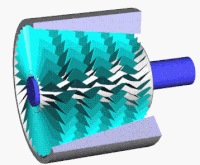
Photo from wikipedia
Abstract Experimental study was carried out on the combustion characteristics of buoyant turbulent diffusion propane flame with fuel volume fraction ranging from 0.2 to 1.0 by nitrogen addition. The combustion… Click to show full abstract
Abstract Experimental study was carried out on the combustion characteristics of buoyant turbulent diffusion propane flame with fuel volume fraction ranging from 0.2 to 1.0 by nitrogen addition. The combustion characteristics reported include total flame length, flame diameter, soot free length fraction (SFLF), axial temperature distribution, maximum axial temperature and flame radiation fraction. Results show that the total flame length and flame diameter are insensitive to nitrogen addition. Soot free length fraction was found to be proportional to ( 1 + S ) 1 S - 0.5 f v , f u e l - 1 . The axial temperature near the burner decreases while increases at higher height with nitrogen addition. The maximum axial temperature increases at first then decreases with nitrogen addition. The different trends in axial temperature characteristics are brought by two competitive effects between cooling effect and declined radiative heat loss due to nitrogen addition. The flame radiation fraction decreases with nitrogen addition due to soot reduction and is found to be proportional to ( 1 + S ) - 0.25 S 0.125 f v , f u e l 0.25 based on theoretical analysis and experimental results. The correlation result is compared to the previous data indicating good applicability.
Journal Title: Fuel
Year Published: 2019
Link to full text (if available)
Share on Social Media: Sign Up to like & get
recommendations!